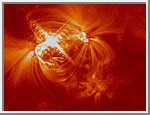|
COMETS EARTH JUPITER KUIPER BELT MARS MERCURY METEORITES NEPTUNE OORT CLOUD PLUTO SATURN SOLAR SYSTEM SPACE SUN URANUS VENUS ORDER PRINTS
PHOTO CATEGORIES SCIENCEVIEWS AMERICAN INDIAN AMPHIBIANS BIRDS BUGS FINE ART FOSSILS THE ISLANDS HISTORICAL PHOTOS MAMMALS OTHER PARKS PLANTS RELIGIOUS REPTILES SCIENCEVIEWS PRINTS
|
Related Document
Download Options
This sequence of solar images was taken using NASA's Transition Region and Coronal Explorer (TRACE) spacecraft on July 14, 1998. Coronal loops, immense coils of hot gas on the surface of the Sun, vibrate wildly after the blast wave from a solar flare hits them. The flare is the bright area in the top left of each image, with surrounding coronal loops below and to the right. The X-shaped starburst pattern is just an instrument artifact. In the middle (trace02.htm) and bottom (trace03.htm) images, the displacement of the bottom loops is prominent as the flare blast wave hits them and they snap back to their original position. This causes them to vibrate back and forth for several minutes. However, their dance is quickly squelched by resistance from the Sun's outer atmosphere (corona). The corona restricts motion due to internal friction hundreds of millions of times greater than expected, according to recent observations from NASA's Transition Region and Coronal Explorer (TRACE) spacecraft. This friction, called viscosity, may help explain why the corona is more than 100 times hotter than the Sun's surface, a mystery that has occupied solar researchers for decades. Just as a guitar string vibrates when plucked, coronal loops move back and forth after being disturbed by a flare. The new TRACE observations show that, rather than vibrating like they are in thin air, the loops act as if they are trying to vibrate in something much thicker, like pudding. This rapidly halts their swaying motion -- it stops after twelve minutes or so. If the original theories on coronal viscosity were correct, the loops would continue vibrating for more than a week. Solar physicists suspect that magnetic energy produced by the roiling, electrically charged gases on the solar surface is somehow transferred to the corona, heating it. However, the old theory of a low viscosity corona made the process so inefficient that scientists could not see how it was done. This new discovery reveals a high viscosity corona with a lot of friction that can be used to transfer energy and generate heat much more efficiently. |
